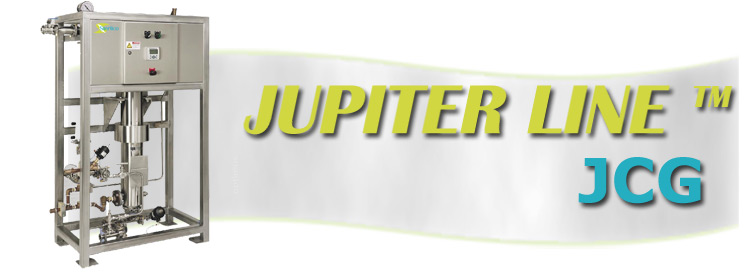
Request a quote for a Jupiter Clean Steam Generator
QUALIFICATION
Construction meets or exceeds the requirements or recommendations of:
-
cGMP Current Good Manufacturing Practices
IMHS Industrial Moist Heat Sterilization: International Standard 11134:1994
ASME American Society of Mechanical Engineers
UL Underwriters Laboratory
CETL Canadian Testing Laboratories (for conformance to CSA)
NFPA National Fire Prevention Association
OSHA Occupational Safety and Health Administration
NPC National Plumbing Code
NEC National Electrical Code
NEMA National Electrical Manufacturers Association
OPERATION
The clean steam pressure is monitored by a pressure sensor that responds to steam demands by operating a pneumatic control valve on the plant steam line. A level switch, simultaneously controlling the feed water supply valve will control the feed water flow. A pressure switch will activate an alarm should the feed water supply pressure drop below the set point. Clean steam pressure will be maintained at 2 psig of the set point.STEAM QUALITY
When fed with pretreated feed water such as de-ionized feed water or USP Purified water, the product will be clean steam. If fed with WFI then the product will be pure steam meeting the requirements of WFI water when condensed.ALLEN BRADLEY PICO CONTROL SYSTEM
The Allen-Bradley PICO Controller automatic controls all the clean steam generator functions. The controller is mounted in a UL listed NEMA 4 panel.EVAPORATOR COLUMN
The evaporator column is constructed in single-tube sheet design. Plant steam is utilized as the heating source on the shell side and feed water is on the tube side. The tube side is constructed in sanitary design with a mill finish. The column is straight-tube 1 pass and ASME code stamped for 150 psig. Material of construction: Shell 304 stainless steel, product side 316L.PIPING AND VALVES
Feed water and product piping and valves are constructed with 316L stainless steel with a mill finish and are constructed in sanitary design. Heating steam and utility lines are constructed of brass.INSULATION
The exterior of the heat exchanger and all hot pipes are covered with chloride-free 2” thick insulation. The insulation on the heat exchanger is encased within sturdy stainless steel.FRAME
The Clean steam generator is secured to a welded structural frame. The frame is constructed of 304 stainless steel. Adjustable screws at the base of the frame allow for leveling during installation.OVERPRESSURE RELIEF
A safety relief valve is equipped to protect the plant steam side of the heat exchanger from over-pressure.Safety relief devices are factory preset for the vessel design pressure and are ASME approved and stamped.
CONNECTIONS
- Feed water – Sanitary 1” Tri-clamp – all models
- Clean Steam outlet – Sanitary 1” Tri-clamp (depending on customer requirements, to be determined during approval drawing process)
- Plant Steam inlet – 1” 150# Flange
- Plant Steam outlet – 1” 150# Flange
- Drain/Vent – ½” NPTF
- Electrical– 120V/1ph Control, 208V/3ph or 600V/3Ph for Booster Pump when feed water pressure is below 90 psig
- Instrument air – ¼” NPT (consumption – 10 scfm)
- Pressure Relief valve – 1” NPT
STANDARD DOCUMENTATION PACKAGE
- Piping and Instrumentation Diagram
- Installation Drawings
- Electrical Diagrams
- Control System Documentation
- Software Source Code Listing
- Installation Manual
- Operational Manual
- Mechanical Component Parts List
- Electrical Component Parts List
- Mechanical Component Catalog Cut Sheets
- Electrical Component Catalog Cut Sheets
FACTORY TESTING
The Clean steam generator is extensively tested at our factory prior to shipment to ensure a trouble free startup of the unit once it arrives at the purchaser’s facility. Tests include mechanical check out, electrical check out, control system check out, input/output testing, alarm initiation testing, and operational check out.